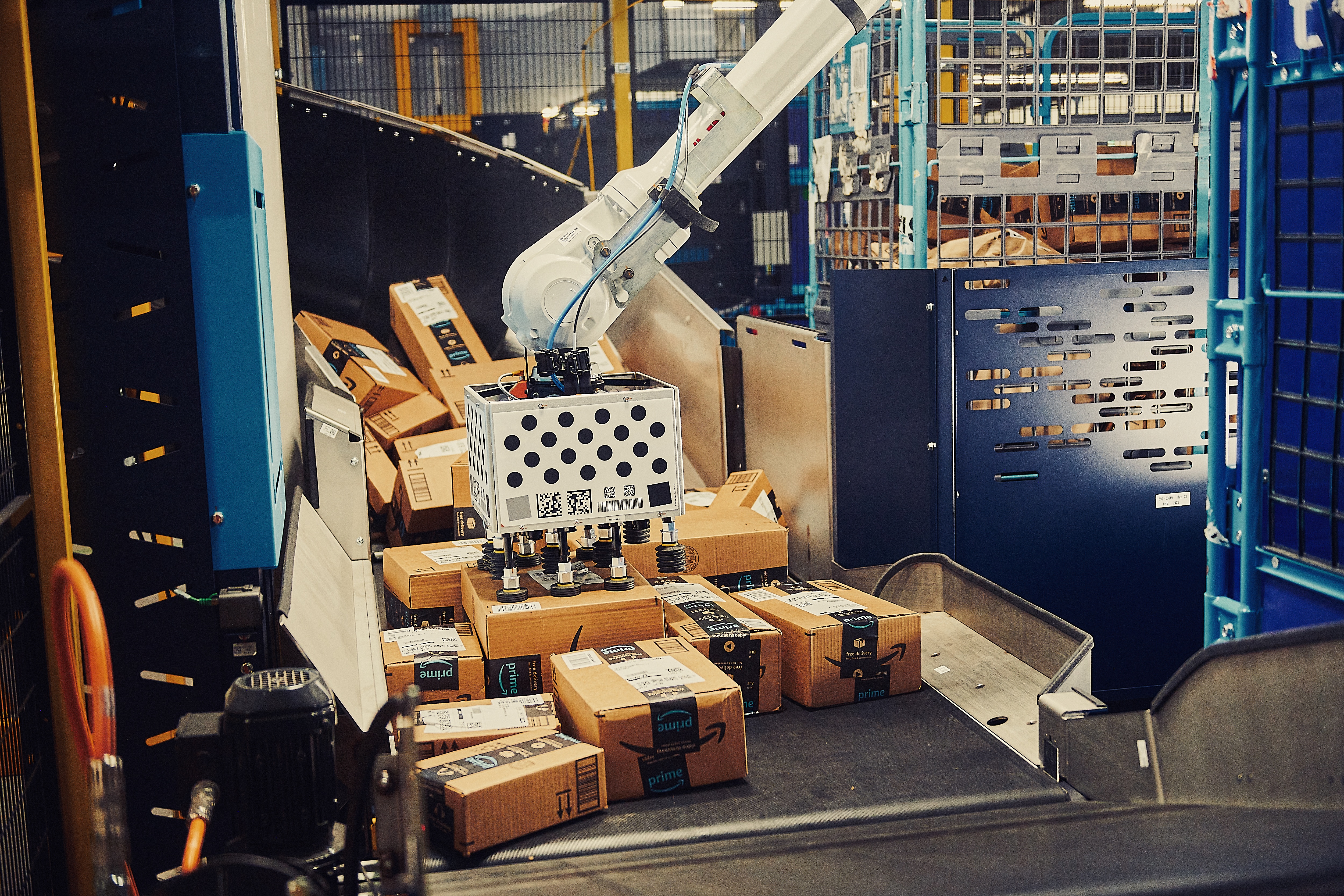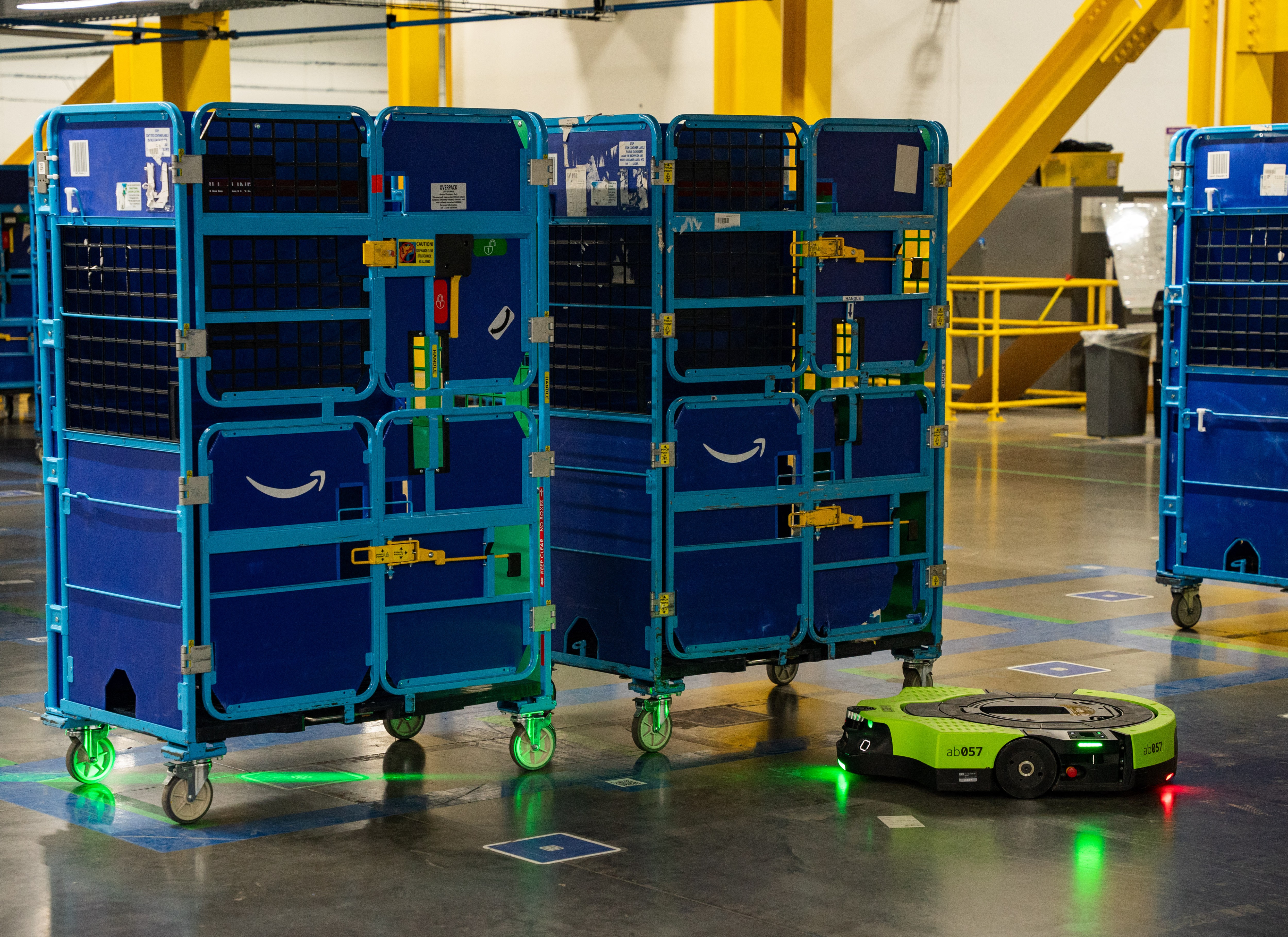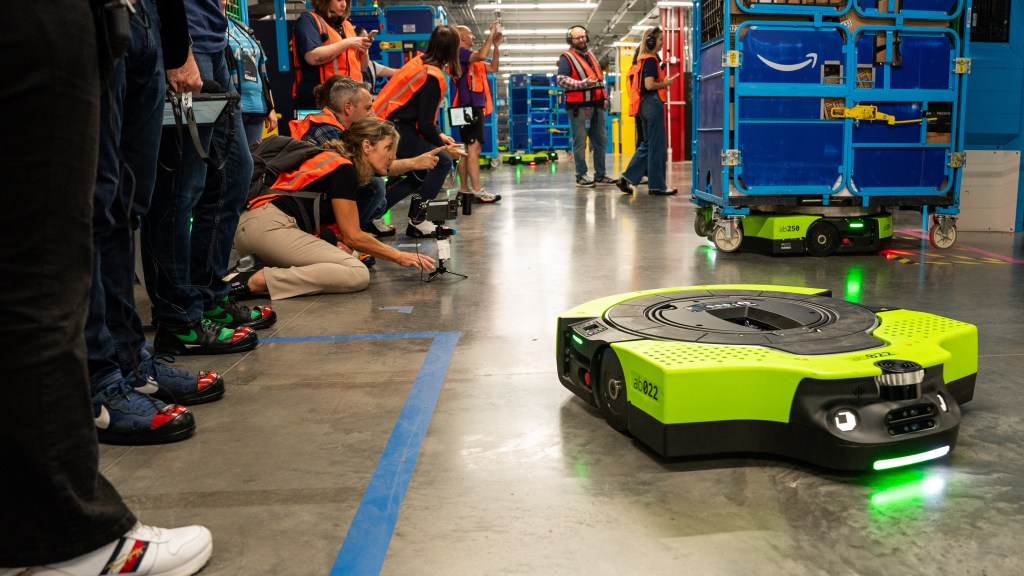Exploring Amazon’s Nashville Warehouse: The Role of Collaborative Robots
Within a large Amazon warehouse in Nashville, Tennessee, innovative robots equipped with eyes and mouths work seamlessly alongside human staff.
Proteus, Amazon’s pioneering “collaborative robot”, debuted two years ago. Following input from its human colleagues, the robot has been enhanced to appear more “friendly”, according to Mikell Taylor, principal technical product manager at Amazon Robotics.
As it navigates the warehouse carrying crates filled with packages, Proteus’s black pupils change into arrows indicating its intended direction. A green light resembling a mouth switches to red when a human is in its path, and it lets out three “yelp” sounds.
“Our goal was to make Proteus endearing; features like its face, expressive eyes, and the sounds it makes were carefully designed for this purpose,” stated Julie Mitchell, director of Amazon Robotics. She described the robot as “just so darn cute” during its field-testing phase to gather user feedback.
Proteus represents the beginning of Amazon’s vision to enhance robotics collaboration with humans while expanding automation in its logistics operations.
“We aim to integrate our robots into the workspace rather than segregate them,” Mitchell elaborated. Unlike other Amazon robots which are enclosed for safety, Proteus roams freely, utilizing sensors to detect and avoid obstacles in its environment.
Proteus can transport weights of up to 880 pounds and works in conjunction with another robot called Cardinal, which sorts packages by zip code and loads them onto carts. Proteus then transports these carts from the outbound area to loading docks for deliveries.

Mitchell pointed out that Proteus’s safety system can serve as “a fundamental element” for expanding collaborative robotics technology. Remarkably, there have been no safety incidents associated with Proteus during its operational lifespan.
As the largest industrial logistics manufacturer globally, Amazon continues to invest heavily in robotic technology to bolster its e-commerce reach. The company has introduced 750,000 robots throughout its operations, matching the number of full- and part-time employees worldwide.
This week, Amazon showcased its plans for a next-generation warehouse at a massive fulfillment center in Louisiana, roughly the size of 55 football fields, featuring ten times more robots compared to existing facilities like the one in Nashville. This site incorporates eight distinct robotic systems to manage the increased volume and speed of package processing.
Centrally located at this facility is Sequoia, an innovative inventory system capable of holding over 30 million items. It coordinates thousands of mobile robots along with various robotic arms to fetch items for employees at their workstations.

As inventory and parcels are processed, three AI-powered robotic arms — Robin, Cardinal, and Sparrow — sort customer orders before transferring them to Proteus for delivery. The newest Sparrow model can assess objects and modify its grip to handle over 200 million products effectively.
According to Amazon, its latest warehouse in Shreveport, Louisiana, which opened in May, has achieved a 25 percent drop in its “cost to serve”, representing the expense of delivering products from Amazon to customers. The integration of continuously operating robots enables the company to optimize costs while enhancing delivery speeds.
Mitchell referred to this process as the Amazon “flywheel”, illustrating how robotic systems create a “positive feedback loop” that not only accelerates delivery but also broadens the variety of products available for shipment, thus quickly justifying the investment in technology.
She expressed optimism about further reductions in delivery costs, potentially reaching 50 to 75 percent in the future. “Our ambitions continue to grow,” she remarked.
The rise of robotics in Amazon’s operations has led to a decrease in the number of human employees per square foot. However, Amazon affirms that this does not spell the end for human roles in warehouses. The Shreveport center is expected to employ around 2,500 workers, similar to the nearly 3,000 individuals at the Nashville fulfillment center, which has a comparable capacity.
“Automation doesn’t equate to a minimal human presence,” Mitchell clarified. “Challenges are inevitable in the real world, including unexpected situations like spills or packaging issues. Therefore, we always rely on our employees to maintain system efficiency and functionality.”
Workers who previously handled heavy lifting and packing are being assigned to assist robots in more manual tasks.
Training for new hires, such as high school graduates, can be as brief as five minutes for basic robot maintenance, although certain roles require more complex training for technical repairs.
Amazon faces the challenge of reassuring current and prospective employees regarding the impact of automation. A recent survey conducted by MIT researchers among over 9,000 workers across nine countries revealed that American employees are among the most skeptical about automation’s effects on pay and job security.
In contrast, workers in countries like France, Germany, Italy, and Spain, known for robust social safety nets, perceived automation’s impact on wages and job security more positively. Conversely, in countries with more liberal market economies, including Australia, the UK, and the US, perceptions leaned towards neutral or negative regarding job security and pay implications. This survey was conducted by Ipsos and sponsored by Amazon.
Ben Armstrong, executive director and research scientist at MIT, advocates for a balanced approach to automation in the workplace. “Employers should focus on establishing trust in automation, allowing employees to rely on technology while remaining vigilant, as it is a partnership between humans and machines,” he stated.
Will automation ultimately lead to an upskilled workforce? Armstrong highlighted a trend over the last four decades in the US and UK, indicating a disparity in job opportunities: increased availability of low-skill jobs, stagnant wages, and a decline in middle-skill roles, raising concerns about displaced workers moving into lower-wage paths.
In Shreveport, the proportion of skilled job openings exceeds that of other warehouses by 30 percent, presenting Amazon with an opportunity to create career advancements and enhance retention rates.
So, how reliable are Amazon’s robots in terms of safety? Mitchell assured, “They are task-oriented and programmed to follow specific instructions, ensuring a safe working environment with no risk of malfunctioning.”




Post Comment